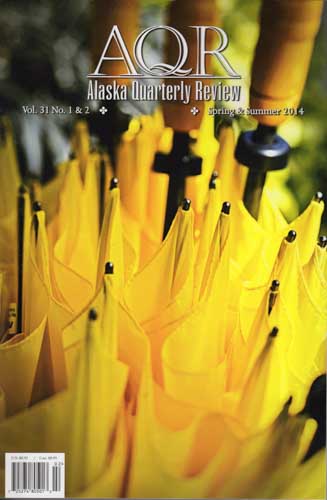Alaska Quarterly Review – Spring/Summer 2014
Good grief, literally. Don’t let the vibrancy of those yellow umbrellas on the cover lull you into a state of blissful aesthetic appreciation; a hard rain’s gonna fall. The short stories, nonfiction, and poetry in the Alaska Quarterly Review’s (AQR) latest issue are soaked with serious consequence, with writers delving into the subjects of madness, financial distress, war, disease, alcoholism, and plain old existential funk. Only the writers’ leavening of such heavy subject matter with great humor, insight, and tart individuality kept me from developing a low-grade Zoloft habit while making my way through the 300-plus pages of this literary squall.
Good grief, literally. Don’t let the vibrancy of those yellow umbrellas on the cover lull you into a state of blissful aesthetic appreciation; a hard rain’s gonna fall. The short stories, nonfiction, and poetry in the Alaska Quarterly Review’s (AQR) latest issue are soaked with serious consequence, with writers delving into the subjects of madness, financial distress, war, disease, alcoholism, and plain old existential funk. Only the writers’ leavening of such heavy subject matter with great humor, insight, and tart individuality kept me from developing a low-grade Zoloft habit while making my way through the 300-plus pages of this literary squall.
My favorite piece of fiction was Sarah Cornwell’s short story “The Benevolent Society.” It is the tale of a nineteenth century housewife forced to participate in the dull do-gooding of a group of townswomen in order to maintain the family name as financial straits threaten to upend the domestic comfort she’s grown accustomed to. Inspired by the activist Dorothea Dix, these townswomen take it upon themselves to volunteer Becky to board one of the madwomen from the local prison until a more humane place in the state asylum is secured. Cornwell’s writing deftly captures the creeping disdain Becky harbors for the strongly held judgments of others as her own social position grows less certain.
The issue also features two inventive and unsettling war stories that grapple with the struggles of active duty and post-military life. In his short story “I Saw Your Ad for a Trumpeter,” James Warner chronicles the plight of Specialist Gared Drezdon on a base in Afghanistan as he spends his morning interrogating prisoners and trying to come up with a suitable entry for a New Yorker-style cartoon caption contest. Warner uses this device to great effect, characterizing other soldiers based on their caption suggestions for the absurd cartoon. That we know Drezdon’s own absurd version of normalcy can be punctuated by extreme outbreaks of violence makes Warner’s story all the more trenchant.
In Arna Bontemps Hemenway’s dark and structurally-complex short story “The Fugue,” the life of an unmoored Iraq War veteran nicknamed Wild Turkey grows less and less coherent as the blackouts he’s suffered since childhood are exacerbated by a powerful cocktail of medicine, memory, and alcohol. Hemenway’s story is a jarring meditation on the power of a traumatized psyche to distort reality and strip life of the narrative thread that keeps one from getting the spins.
Alyssa Knickerbocker’s “The Uncertain Future of the Body” is one of three exceptional pieces of work in this issue to feature voluble female characters dealing with cancer’s effect on the family. While Andrew D. Cohen’s nonfiction piece “Looking at Sheila” and Julia MacDonnell’s short story “Dancing with Ned” were quite good, the characters in Knickerbocker’s story were particularly memorable and vivid. The playfully combative mother-daughter relationship Knickerbocker so soulfully creates makes her tale of diagnosis and missed opportunities more moving, and, at times, outright hilarious: “‘Just think,’ she said, blowing her cigarette smoke out her nostrils. ‘I’ve been feeling myself up for decades, doing those stupid self-breast exams, and then wham! It comes at me from the crotch.’”
The seventy pages of poetry in the issue shade towards the serious as well, and include a collection of eighteen new poems from Joan Naviyuk Kane. Michael Hettich’s hypnotic, image-driven “The Shells” and Terese Coe’s “Godardian” made the most lasting impressions. Hettich’s poem uses the image of washed-up shells to found a meditation on the whims of fate and our sad reliance on those whims to incite change in our lives. The intricate pacing of Hettich’s poem turns territory that could be cliché into amazing art. Coe’s short poem “Godardian,” with its title seemingly meant as visual pun that suggests a connection between the auteur director and the mythic knot, considers the impossible task of extricating love from desire in a subjective world:
And what you are and what I think you are,
they’re not the same.
I see this when I think
of coming to you, and when I am with you
Coe’s slippery poem manages to enact rather than simply suggest the feeling of unease.
For more than thirty years AQR has provided a stable of returning contributors as well as many emerging writers with a venue for literary art that is serious but not self-important. With great skill and artistry, the writers in AQR’s latest issue continue this tradition.
[www.uaa.alaska.edu/aqr]





